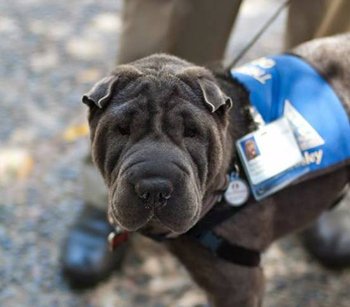It’s not unusual to become frightened, discouraged or depressed when you’re sick or in pain. Undergoing medical treatments or procedures also can be stressful.
In times like those, the calming presence of a people-loving pooch may be the best medicine.
The people who run UC Irvine Medical Center’s Pet Therapy Program know well what petting a warm and affectionate dog can do to help patients heal, having watched the animals bring smiles and lift the spirits of patients for nearly two decades.
Currently, the pet therapy program’s 13 dog-and-handler teams regularly visit patients in the medical center’s orthopedic, rehabilitation, cancer, senior center, physical therapy and other areas seven days a week with remarkable results, says Barbara Arbour, manager of patient relations and volunteer services for UCI Health.
See our therapy dogs in action
A soothing, wet-nosed presence
She recalls the time a patient at the UC Irvine Chao Family Comprehensive Cancer Center was so anxious about his treatment that his blood pressure soared to dangerous levels. After a therapy dog jumped into his lap, the man relaxed enough to start his chemotherapy in the infusion center.
The parents of a young girl who lay unconscious for days in the hospital asked that a therapy dog visit daily. Each time they’d gently place their daughter’s hand on the dog’s side until one day they noticed her fingers moving through its fur.
Even medical students ask to have the dogs come to relieve their stress during finals.
Therapy dogs’ influence is measurable
“There’s scientific evidence to support these benefits,” says Michael Steinhardt, who is training his third therapy dog, Buster, to volunteer at the medical center in Orange.
“Visits from the dogs help reduce blood pressure, lower anxiety and stress levels, reduce perceptions of pain and stimulate the release of endorphins, making people feel good,” says Steinhardt.
“That is especially important for those who are feeling lonely, isolated or depressed. When an animal connects with a patient, and with staff members and visitors, you can see it in their faces — it’s a beautiful thing.”
Pet therapy started at UC Irvine Medical Center long before Arbour arrived, but she continues to build the program. “Our goal is to bring in as many pet therapy teams as we can, but it’s not easy to find them,” she says.
What makes a good pet therapy team?
Dogs need to be:
- Well-socialized
- Obedience-trained
- Generally immune to distractions, loud noises and strange smells
The real key, though, is that the dog must enjoy interacting with people of all kinds.
Handlers must have a close bond with their dog and be experienced at working with them in any type of situation to prevent accidents or injuries. They also need to be their dog’s advocate, reading the animal’s cues to ensure it doesn’t become overtaxed.
If you think you and your dog would enjoy helping UCI Health patients, recognize that it’s a big time commitment, Arbour says.
Would your dog qualify?
Here’s what’s involved:
- Dogs must be certified as a pet therapy dog by reputable organizations such as Pet Partners, Pet Prescriptions and Therapy Dogs International.
- Dogs and their handlers are required to attend a UCI Health workshop, and then undergo an evaluation to determine if they are a good fit for the program.
- The dog must have proof of recent vaccinations, including a rabies shot.
- The handler also must receive a medical clearance; undergo background checks and an orientation.
- The handler and dog also must make a commitment to visit with patients a total of 100 hours, visiting between 10 and 20 patients during each shift of no more than 2 hours.
- Dogs must be groomed within 24 hours before each visit.
 Healthcare VIPs
Healthcare VIPs
The pet therapy dogs are practically celebrities at the medical center, regularly drawing crowds and lots of oohing and aahing.
“We provide handlers with trading cards that have a picture and information about their dog to hand out to patients,” says Sandra Serrano, assistant manager of volunteer services for UCI Health.
“They also get a scarf, a UCI badge and free parking.”
Steinhardt, a pet lover with a penchant for volunteerism, got into pet therapy in 2011 after seeing how positively people reacted to the wrinkled muzzle of Bosley, his beloved Chinese shar-pei, wherever they went.
Making a difference
Before he passed away, Bosley worked as a therapy dog for about three years — much of it at the medical center — and touched the lives of almost 6,000 people, Steinhardt says. His personal Facebook page accumulated some 900 friends.
“When you see the difference a therapy dog can make in a patient’s life,” says Steinhardt, “it’s a win for everyone.”
Related Stories



